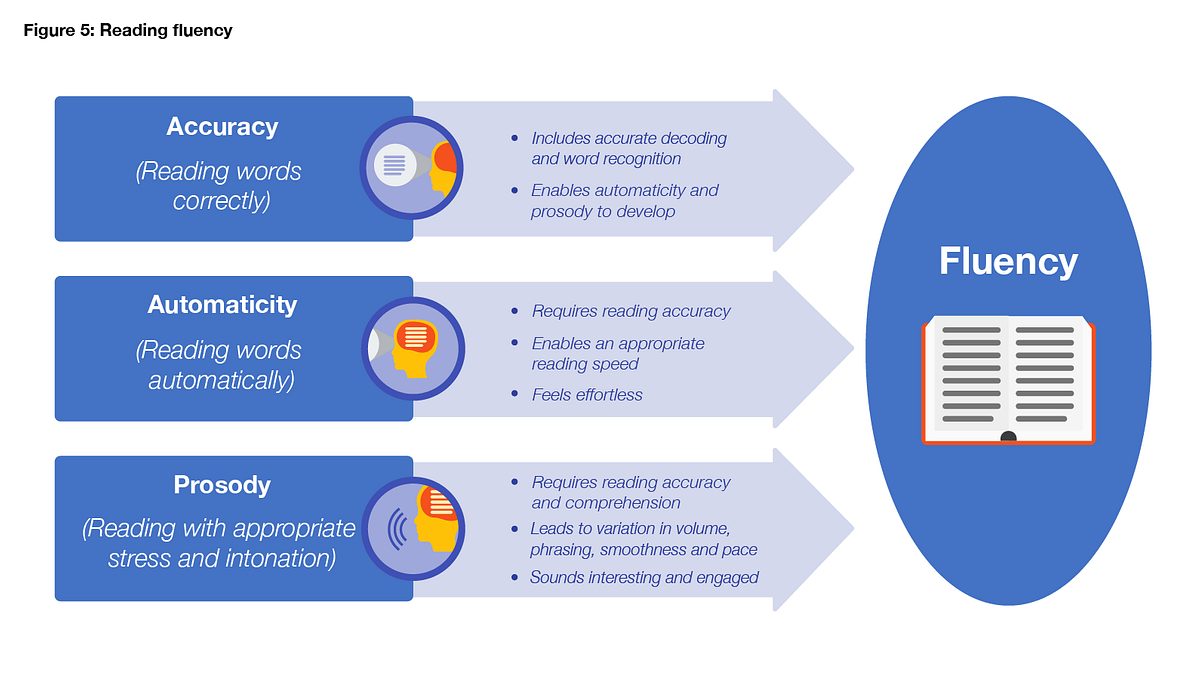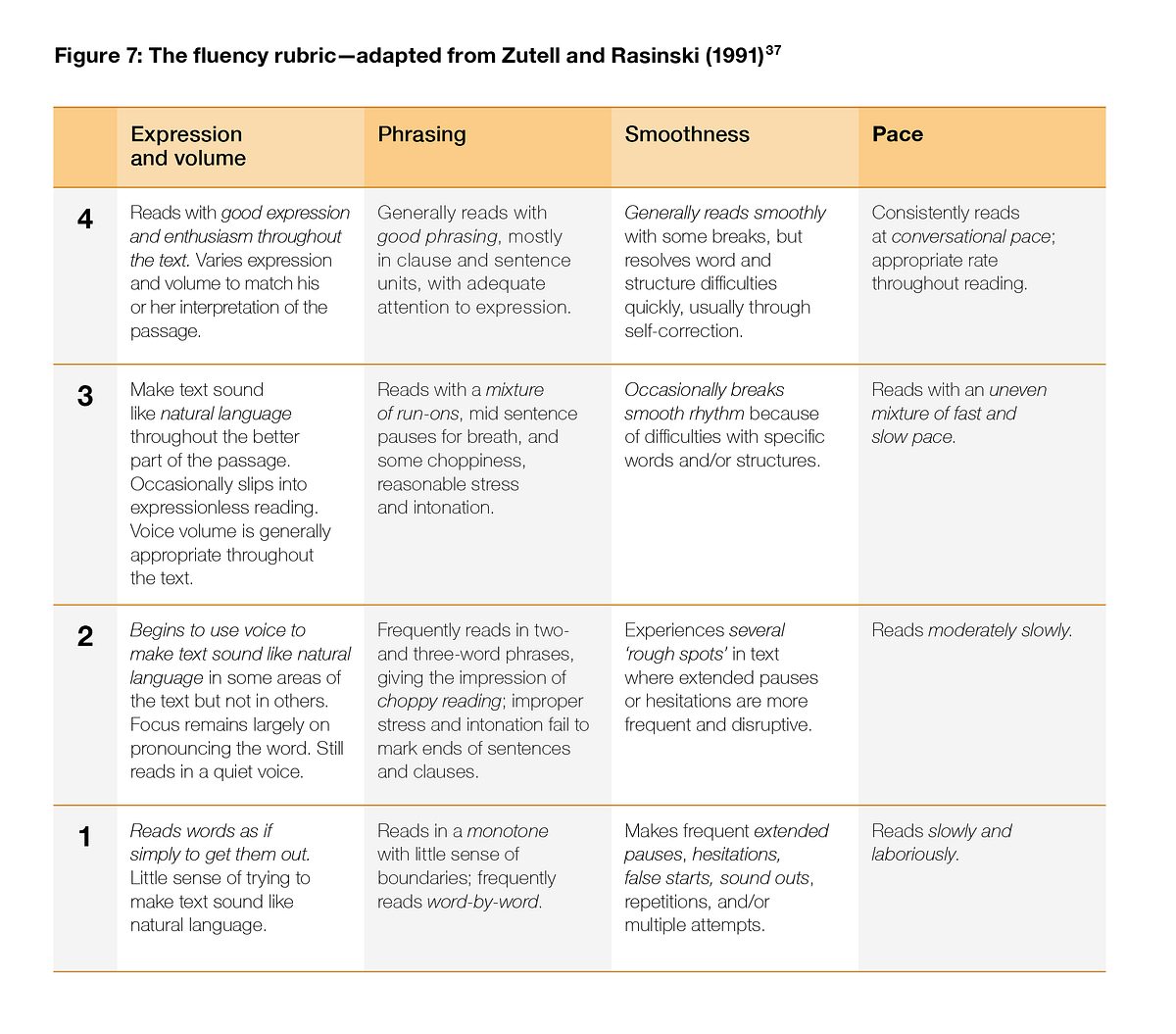There is a wealth of evidence which highlights the important role fluency plays in pupils’ reading development. But what really is it? Why is it significant? How should we approach teaching fluency in our day-to-day teaching practice?
What is fluency?
The word ‘fluency’ comes from the Latin word ‘fluentem’ meaning ‘to flow’.
As explained in our updated ‘Improving Literacy in KS2’ guidance report, in the context of literacy, reading fluency is defined as reading with accuracy (reading words correctly), automaticity (reading words at an appropriate speed without great effort) and prosody (appropriate stress and intonation).

These three key elements of fluency are important skills in isolation, but they also work as interdependent building blocks. If one building block isn’t secure, then reading fluency is difficult to achieve. For example, a pupil might struggle with automaticity if they are not decoding accurately. Similarly, effective prosody is reliant upon pupils being able to read words automatically, with ease and appropriate pace, if a text is to be brought alive with expression.
So, why is fluency important?
Fluent reading supports reading comprehension. When pupils read fluently, their cognitive resources can be redirected from focusing on decoding and onto comprehending the text. For this reason, fluency is sometimes described as a bridge from word recognition to comprehension.
Tim Shanahan (2019) says we need to teach reading fluency because it helps pupils to understand how print works, how to develop and consolidate automatic decoding skills, and how to bring a text to life from print to prosody.
Most pupils will benefit from an emphasis on the explicit teaching of fluency as part of a multi-faceted approach to teaching reading. However, it is important to start with identifying pupils’ capabilities and accurately diagnosing areas where they may need further instruction. For instance, some pupils may benefit from additional support beyond whole-class teaching.
A fluency scale rubric, like the one adapted from Zutell and Rasinski (1991), is a useful tool to support with this:

When assessing pupils’ strengths and weaknesses in relation to reading fluency and monitoring their progress, asking thoughtful questions will help to inform the next steps in teaching:
- Do pupils need more explicit fluency instruction?
- Do pupils need more planned opportunities to practise fluency?
- Do pupils need more specific feedback on how to improve fluency?
- Are pupils struggling due to underlying weaknesses in decoding letters into sounds?
How might this translate to the classroom?
One evidence-informed approach is guided oral reading instruction. This involves an adult modelling the fluent reading of a text first and then pupils reading the same text aloud with appropriate feedback. It is an opportunity to make the implicit explicit by expertly modelling fluency through appropriate use of pace, expression, punctuation and phrasing – all important features of effective prosody.
Another approach to consider is repeated reading. This involves pupils re-reading a short text a set number of times or until they reach a suitable level of fluency. It is a great way to develop accuracy and automaticity when encountering complex tier 2 and 3 vocabulary in a subject with complex language like science.
.An engaging way to incorporate both of these approaches is the use of ‘Readers’ Theatre’. With this approach, pupils are given opportunity to practise and perform fluency strategies, such as repeated reading, paired reading, text marking for phrasing, and peer feedback. It also has the added bonus of supporting pupils’ understanding of texts at the same time.
Ultimately, the goal of teaching reading is to enable children to comprehend written texts. To do this, pupils need to build both word reading and language comprehension skills. However, developing reading fluency can provide a crucial bridge between the two, continually supporting pupils’ progression from learning to read to reading to learn.
If you’re interested in learning more about ‘Readers’ Theatre’, I’d highly recommend reading the blog ‘How I teach reading fluency’ by Town End Research School’s Stella Jones – which explores how this classroom strategy can be implemented effectively.
References
1. Rasinski, T.V (2012) Why reading fluency should be hot! The Reading Teacher, International Reading Association, 65 (8), 516 – 522. See here
2. EEF Improving Literacy in Key Stage 2 (2021). See here
3. Shanahan, T (2019) Wake up reading wars combatants: fluency instruction is part of the science of reading, Shanahan on Literacy. Available at Oral Reading Fluency | Shanahan on Literacy (Accessed: 18th November 2021)
